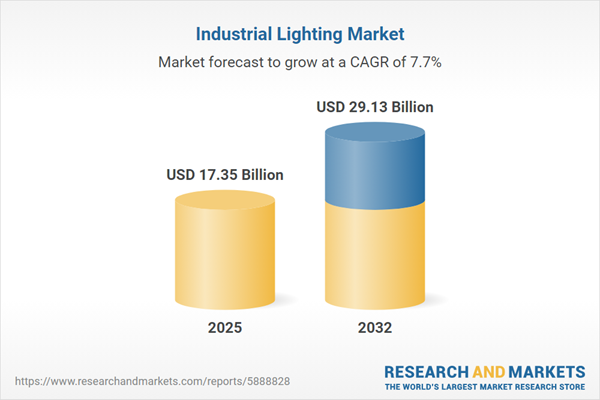Speak directly to the analyst to clarify any post sales queries you may have.
The industrial lighting market is rapidly evolving as businesses seek energy efficiency, digital connectivity, and compliance with increasingly stringent sustainability mandates. Senior leaders in manufacturing, logistics, and other heavy industries face new opportunities—and pressures—as advanced lighting technologies reshape operational strategies.
Market Snapshot: Industrial Lighting Market Growth & Outlook
The industrial lighting market grew from USD 16.12 billion in 2024 to USD 17.35 billion in 2025. It is expected to continue growing at a CAGR of 7.67%, reaching USD 29.13 billion by 2032. Robust growth is driven by the widespread shift from legacy lighting systems to innovative, smart, and energy-efficient solutions. This momentum is particularly noticeable in manufacturing facilities, warehouses, logistics centers, and large-scale outdoor venues, as companies seek lighting systems that maximize productivity while minimizing lifecycle costs and regulatory risks.
Scope & Segmentation
This report delivers comprehensive coverage of core industrial lighting technologies, applications, products, and end-user contexts across global key regions. The scope specifically addresses evolving stakeholder demands and market trends shaping procurement and investment strategies.
- Technology: Fluorescent, Halogen, HID, Induction, LED.
- Product Type: Flood Lighting, High Bay Lighting, Low Bay Lighting, Panel Lighting, Street Lighting, Tube Lighting.
- End User: Automotive, Food and Beverage, Logistics, Manufacturing (Discrete Manufacturing, Process Manufacturing), Mining, Oil and Gas, Pharmaceutical, Power Generation, Warehousing.
- Application: Indoor (Cold Storage, Manufacturing Facility, Warehouse), Outdoor (Parking Lot, Sports Venue, Street).
- Distribution Channel: Direct Sales, Distributors, Online Sales, Original Equipment Manufacturers.
- Region: Americas (United States, Canada, Mexico, Brazil, Argentina, Chile, Colombia, Peru), Europe, Middle East & Africa (United Kingdom, Germany, France, Russia, Italy, Spain, Netherlands, Sweden, Poland, Switzerland, United Arab Emirates, Saudi Arabia, Qatar, Turkey, Israel, South Africa, Nigeria, Egypt, Kenya), Asia-Pacific (China, India, Japan, Australia, South Korea, Indonesia, Thailand, Malaysia, Singapore, Taiwan).
- Company Profiles: Signify N.V., Acuity Brands, Inc., Eaton Corporation plc, Zumtobel Group AG, ams OSRAM AG, Hubbell Incorporated, LEDVANCE GmbH, Fagerhult AB, Cree, Inc., Dialight plc.
Key Takeaways: Strategic Insights for Decision-Makers
- The global push for digital transformation is accelerating the integration of sensor networks and IoT frameworks in industrial lighting, enabling real-time monitoring and adaptive performance.
- Energy efficiency mandates are compelling companies to prioritize solutions that reduce operational costs, including retrofit opportunities for existing facilities seeking to maximize current infrastructure.
- Smart lighting convergence is fostering better coordination with security, environmental, and power management systems, improving overall facility safety and operational resilience.
- Sector-specific needs—such as color precision in automotive or durable fixtures in mining—are driving increased customization and modularity in lighting products.
- Distribution strategy remains crucial: direct sales facilitate tailored site solutions, while partnerships with OEMs and online channels support agility and procurement speed.
Tariff Impact: Navigating United States Supply Chain Shifts
The revised tariff structures introduced in the United States from 2025 are prompting manufacturers and distributors to scrutinize procurement and supplier networks. Increased costs for imported lighting components underscore the need for nearshoring strategies and domestic sourcing to mitigate unpredictability in trade policy. As organizations adapt, some are accelerating the adoption of higher-efficiency lighting options to achieve faster return on investment amidst elevated capital expenditures.
Methodology & Data Sources
This report applies a rigorous mixed-method approach, combining primary interviews with industry managers, procurement directors, engineers, and policymakers, with extensive secondary analysis from authoritative databases and technical publications. All data points are validated through cross-source triangulation and benchmarked against regional market trends.
Why This Report Matters
- Provides a comprehensive, actionable analysis of the industrial lighting industry, helping stakeholders identify emerging technology trends and procurement best practices.
- Supports investment and sourcing decisions through in-depth segmentation and regional insights, ensuring alignment with operational and sustainability targets.
Conclusion
Advanced industrial lighting is reshaping how companies approach productivity, compliance, and cost control. This report equips senior executives to navigate fast-evolving technology options, regulatory shifts, and supply chain complexities with clarity and confidence.
Additional Product Information:
- Purchase of this report includes 1 year online access with quarterly updates.
- This report can be updated on request. Please contact our Customer Experience team using the Ask a Question widget on our website.
Table of Contents
3. Executive Summary
4. Market Overview
7. Cumulative Impact of Artificial Intelligence 2025
Companies Mentioned
The companies profiled in this Industrial Lighting market report include:- Signify N.V.
- Acuity Brands, Inc.
- Eaton Corporation plc
- Zumtobel Group AG
- ams OSRAM AG
- Hubbell Incorporated
- LEDVANCE GmbH
- Fagerhult AB
- Cree, Inc.
- Dialight plc
Table Information
| Report Attribute | Details |
|---|---|
| No. of Pages | 196 |
| Published | October 2025 |
| Forecast Period | 2025 - 2032 |
| Estimated Market Value ( USD | $ 17.35 Billion |
| Forecasted Market Value ( USD | $ 29.13 Billion |
| Compound Annual Growth Rate | 7.6% |
| Regions Covered | Global |
| No. of Companies Mentioned | 11 |









